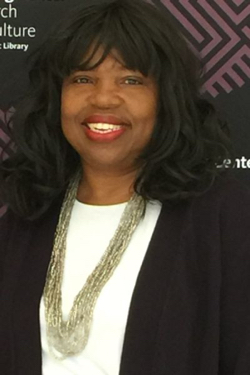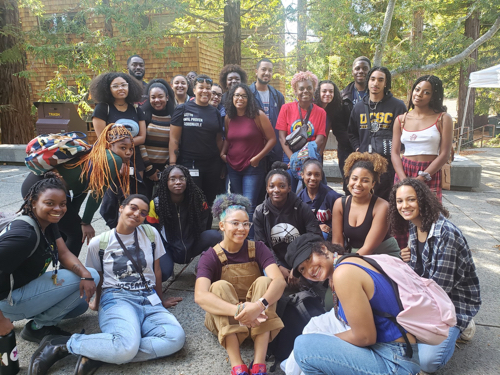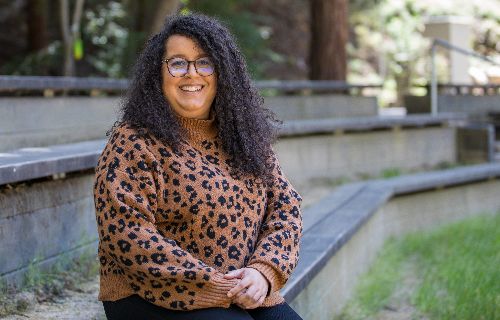In the late 1980s, African American students at UC Santa Cruz were losing patience.They were not feeling supported by the campus and had grown tired of advocating for themselves. The 21 percent six-year graduation rate for African American students underscored the challenges they faced.
Out of desperation, student protesters peacefully surrounded the Hahn building, demanding the administration make meaningful change for students of color at UC Santa Cruz.
Then–Student Services Vice Chancellor Bruce Moore met with the student leaders and negotiated a solution. On April 1, 1991, UC Santa Cruz alumna Sister Paula Livers-Powell (M.A. '89, history) became the new assistant dean of African American student life, starting what would become the African American Resource and Cultural Center. This year, the center celebrates its 30th anniversary as a key part of the university community.
“It was like a prayer answered for the students,” said Livers-Powell, who served in the capacity of founding director for 21 years and retired from the university in 2010. She now pursues her passion as a genealogist and founder/publisher of BlackbytheBay.com.
Today, African American students have a dramatically improved six-year graduation rate of 65.6 percent, more than triple what it was, and UC Santa Cruz continues to focus on student success with a goal of eliminating achievement gaps and improving graduation rates.
Livers-Powell said the connections, encouragement, and programs the center offers have played a big role in achieving that higher rate.
Advancing student involvement and success
Located today on the third floor of the Bay Tree Building within the Ethnic Resource Centers, the center facilitates student involvement and success on campus. It has worked closely with or supported numerous groups at the university, including the African/Black Student Alliance, the National Society of Black Engineers, the African American Theater Arts Troupe, and more.
Even in the midst of the COVID-19 pandemic shutdowns, the center continues on with a variety of virtual programs, including Black Academy, Black in STEM talks, and career workshops.
“It’s been kind of good and hard at the same time,” said interim director Riana Howard, who just started in the position in July. “We’ve accomplished a lot being remote. But I haven’t met a lot of our students yet, who I would have met if I were on campus.”
Nailah Smith (Stevenson '24, computer science), a first-year student and employee of the center, said she loved AARCC’s recent virtual Black in STEM workshop.
“It helped me get connected to other students in my major,” said Smith, who is studying computer science.
Ryleigh Hales (Merrill '21, biochemistry and molecular biology), another student employee of AARCC, said she loved attending Black Academy, which provides an orientation to the university, shortly after she transferred in fall 2019.
She appreciated meeting other Black students and learning about ways she could get involved in college life.
“I’m a big believer that if you benefit, you should give back,” said Hales. “I wanted to be part of the team.”
Black Academy
Black Academy, now entering its sixth year, has served some 200 students and has helped connect them with mentors and gain a better understanding of how to achieve success on campus.
Aaron Jones, who worked under the guidance of former AARCC director Shonté Thomas (Rachel Carson '99, politics) to start the program, said he met with many students to help figure out what they needed and overcome obstacles keeping them from finishing their degrees.
He said African American students and other minoritized populations need extra support because “fundamentally higher education was constructed for particular folk.” Higher education has not historically been inclusive, he said. “There is a need for folks that have been historically marginalized—they need spaces on campus where they can feel comfortable, where they can recharge.”
Thomas, who served as director of AARCC for seven years and now serves as associate dean of students for ethnic and gender centers at UC Riverside, said anti-Blackness permeates the world. Unfortunately, she had a bad experience at UC Santa Cruz as an undergraduate, facing explicit racial biases on a regular basis until she graduated in 1999.
Because of that, she was at first reluctant to take on the job leading AARCC, but as she continued, she was glad to be in the job so that she could help improve the lives of not just the constituency but everyone in the university as a whole.
“I remind folks this is freedom work,” she said. “Solidarity and the way we move together so all folks get to a true sense of equity. That is the aim and goal however we get there. That will only happen when all groups are respectful of one another and they have a sense of love and affection for their fellow people.”
She counts the founding of Black Academy as one of her top achievements, along with the fact that during her time at AARCC, more African American students showed up at the lounge to have fun and enjoy being with each other. She worked hard to make the center a home away from home for students.
“I really moved with a sense of ‘if you want to be here, you can be here,’” she said. “I’m proud to contribute seven years of all I could to build our students up.”
A village and a vision
Looking back, Livers-Powell, the founding director, said it took a village and a vision to support the mission of the AARCC. She appreciated the help and support of former staff such as Founding Assistant Director Nancy James-Williams, Duane "Coach" Gardner, and Founding Program Director Kristine O'Neil, the office manager who helped to lay the foundation seen today.
Livers-Powell also feels blessed to have had dedicated AARCC interns, ambassadors, student organizations, faculty, staff, and community allies who contributed to the 30-year legacy of the AARCC.
Livers-Powell never imagined when she started the center that social media would be invented and that she would be able to keep in touch with the students supported by the center. Now when she looks on those sites, she is proud and impressed to see former UC Santa Cruz students sharing their success stories as alumni in a variety of professional endeavors including photographers, writers, lawyers, doctors, and many other careers.
“It’s like growing a garden, being a constant gardener, and now you see the flourishing,” she said. “The seeds keep coming.”





